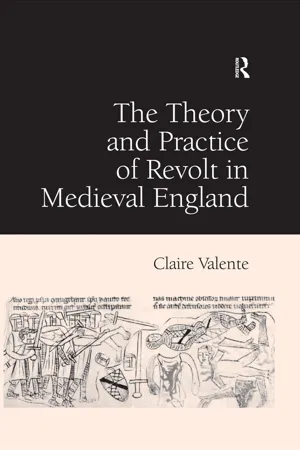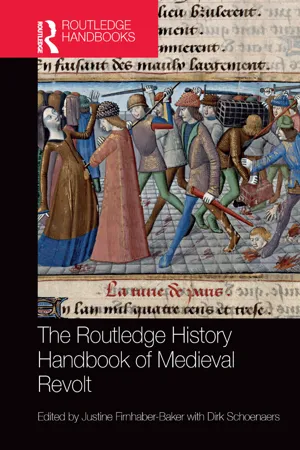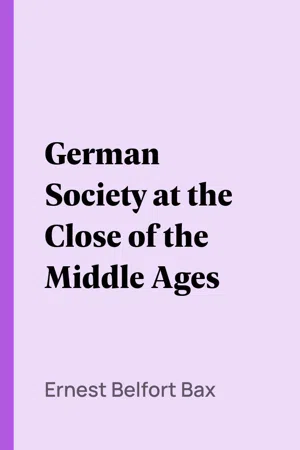History
Knights' Revolt
The Knights' Revolt was a rebellion led by the English barons and knights against King John in the early 13th century. The revolt was sparked by the king's oppressive taxation and arbitrary rule, leading to a confrontation at Runnymede where the Magna Carta was forced upon King John, establishing the principle of limits on royal power and laying the groundwork for constitutional government in England.
Written by Perlego with AI-assistance
Related key terms
3 Key excerpts on "Knights' Revolt"
- Claire Valente(Author)
- 2017(Publication Date)
- Routledge(Publisher)
Chapter 1 Why Study Revolt? My God! this is a strange and fickle land, which has exiled, slain, destroyed, and ruined so many kings, so many rulers, so many great men, and which never ceases to be riven... by dissensions and strife and internecine hatreds. N'ont pas Anglois souvent leurs rois trays? Certes ouyl, tous en ont congnoissance. (Have not the English often betrayed their kings? Of course, we all know that). 1 Medieval Englishmen were treacherous, rebellious, and killed their kings, according to the fourteenth-century English king, Richard II, and a host of fifteenth-century French observers. This opinion, though biased, was not without factual basis. In the period from 1215 to 1415, five out of eight kings fought wars with their subjects; four out of eight were captured and/or deposed, and two were killed. Two others escaped open warfare but encountered vigorous resistance or conspiracy. These dramatic episodes-the imposition of Magna Carta on King John, the murder of Edward II, the 'abdication' of Richard II-have captured the imagination of professional historians, political theorists, poets, dramatists, and artists, as well as the general public, for centuries. Yet the forms which resistance to the king took in medieval England have not been directly examined. This is surprising, given the widespread interest in medieval popular rebellion in the 1970s/, 2 and the revival in the last ten years of the study of violence in medieval society. Recent studies have for the most part focused on violence among the nobility or between kingdoms, with little if any attention to the use of violence against the king. 3 Such violence, however, was a repeated feature of political relations between medieval nobles and their kings, and not just in England. The use of violence reveals noble political ideas; changes in that use reflect developments in government, society, and political culture- Justine Firnhaber-Baker, Dirk Schoenaers, Justine Firnhaber-Baker, Dirk Schoenaers(Authors)
- 2016(Publication Date)
- Routledge(Publisher)
That historiography is shaped by the historical context in which it is written does not necessarily mean that its arguments are wrong, even if we sometimes find them infelicitously phrased. We cannot help but see things from our own vantage, and different perspectives reveal different aspects of the past in different lights. But it is worth unpacking those influences to understand how they have worked in relation with other intellectual currents to create particular views of the historical past, which we now build upon, modify, or utterly eschew. For the study of medieval revolt, it is notable that although the past two centuries have seen major shifts in method and interpretation, some central problems have remained surprisingly constant. The relationship between revolt and the state (however conceptualised), attention to social dynamics and non-elite groups (even if sometimes unfavourable), and a profound concern for language, sources, and source criticism are threads that have run through the scholarship since the beginning of the nineteenth century.The state and the perimeters of ‘revolt’
Studies of medieval revolt have almost invariably organised themselves around the concept of the state as the arena within which revolts take place and take on meaning. For nineteenth-century historians, who saw medieval uprisings as disruptive eruptions and deviations from normal politics, revolts were directed against the state by constituencies outside it who opposed its power. Twentieth-century historians, too, understood revolt as an expression of opposition to the state, especially to the growth of royal governments. Mollat and Wolff, for example, argued that fourteenth-century revolts erupted in protest against ‘the invasion of society by the State’, particularly in terms of tax demands.13 Even in 2006, the rise of the late medieval state was portrayed as something that rebels organised themselves to oppose as an encroachment on ‘liberty’, understood in the modern sense as freedom from hierarchic control.14As should already be clear, most of the essays in this volume envisage the state in a different and more multi-dimensional way than was the case for earlier historians, and this reassessment of the state necessarily entails the reconceptualisation of late medieval revolt. Nevertheless, the relationship between uprisings and their institutional political context remains central in current writing. Indeed, the political ramifications of revolt are perhaps more important to current historiography than they have ever been before. New historiography on late medieval politics has revised the view that the remarkable growth of government in the later Middle Ages was an inherently antagonistic process imposed upon an unwilling population, which was thus primed for rebellion. Historians have increasingly shown that ‘the rise of the state’ was a dialogic process in which the governed had considerable agency, often clamouring for more government rather than less. People employed the infrastructure and even the ideology of late medieval authorities to their own ends, not just accidentally benefiting from the expansion of government but actively abetting and encouraging it.15- eBook - ePub
- Ernest Belfort Bax(Author)
- 2015(Publication Date)
- Perlego(Publisher)
From the foregoing it will be understood that the oppression of the peasant, under the feudalism of the Middle Ages, and especially of the later Middle Ages, was viewed by him as an infringement of his rights. During the period of time constituting mediæval history the peasant, though he often slumbered, yet often started up to a sudden consciousness of his position. The memory of primitive communism was never quite extinguished, and the continual peasant-revolts of the Middle Ages, though immediately occasioned, probably, by some fresh invasion, by which it was sought to tear from the "common man" yet another shred of his surviving rights, always had in the background the ideal, vague though it may have been, of his ancient freedom. Such, undoubtedly, was the meaning of the Jacquerie in France, with its wild and apparently senseless vengeance; of the Wat Tyler revolt in England, with its systematic attempt to embody the vague tradition of the primitive village community in the legends of the current ecclesiastical creed; of the numerous revolts in Flanders and North Germany; of the Hussite movement in Bohemia, under Ziska; of the rebellion led by George Doza in Hungary; and, as we shall see in the body of the present work, of the social movements of Reformation Germany, in which, with the partial exception of Ket's rebellion in England a few years later, we may consider them as coming to an end.For the movements in question were distinctly the last of their kind. The civil wars of religion in France, and the great rebellion in England against Charles the First, which also assumed a religious colouring, open a new era in popular revolts. In the latter, particularly, we have clearly before us the attempt of the new middle class of town and country, the independent citizen, and the now independent yeoman, to assert its supremacy over the old feudal estates or orders. The new conditions had swept away the revolutionary tradition of the mediæval period, whose golden age lay in the past with its communal-holding and free men with equal rights on the basis of the village organisation—rights which with every century the peasant felt more and more slipping away from him. The place of this tradition was now taken by an ideal of individual freedom, apart from any social bond, and on a basis merely political, the way for which had been prepared by that very conception of individual proprietorship on the part of the landlord, against which the older revolutionary sentiment had protested. A most powerful instrument in accommodating men's minds to this change of view, in other words, to the establishment of the new individualistic principle, was the Roman or Civil law, which, at the period dealt with in the present book, had become the basis whereon disputed points were settled in the Imperial Courts. In this respect also, though to a lesser extent, may be mentioned the Canon or Ecclesiastical law,—consisting of papal decretals on various points which were founded partially on the Roman or Civil law,—a juridical system which also fully and indeed almost exclusively recognised the individual holding of property as the basis of civil society (albeit not without a recognition of social duties on the part of the owner).
Index pages curate the most relevant extracts from our library of academic textbooks. They’ve been created using an in-house natural language model (NLM), each adding context and meaning to key research topics.


